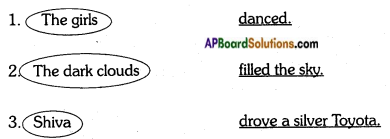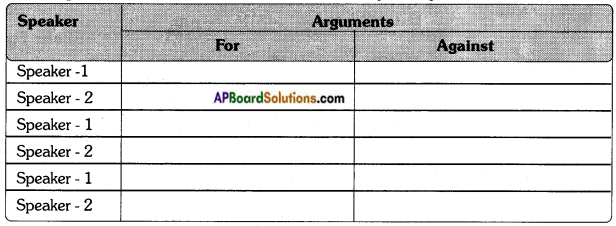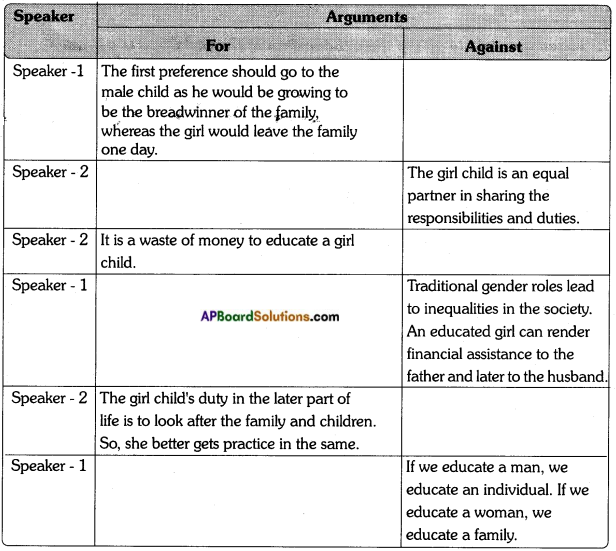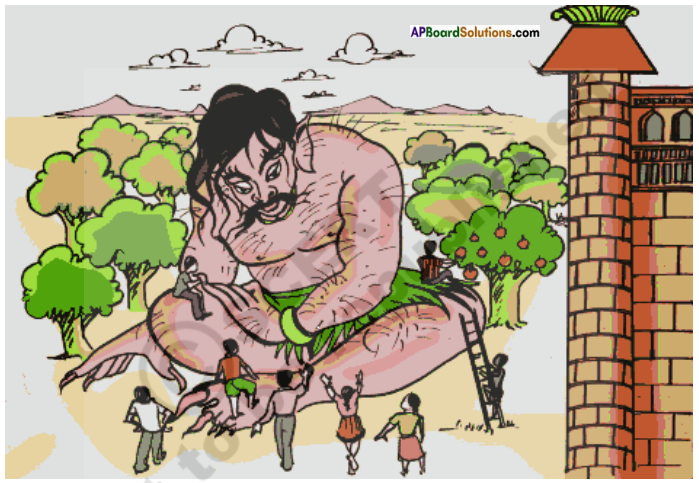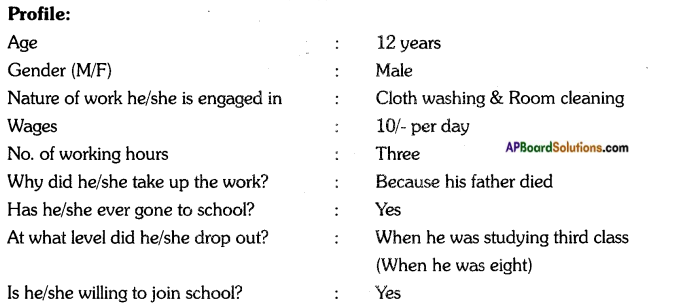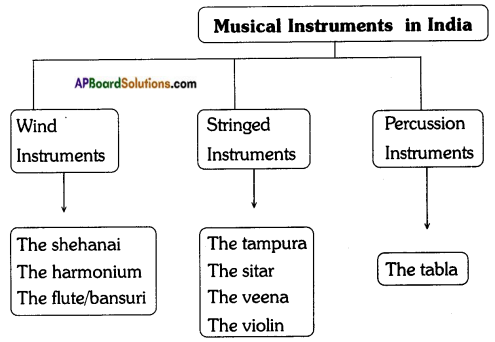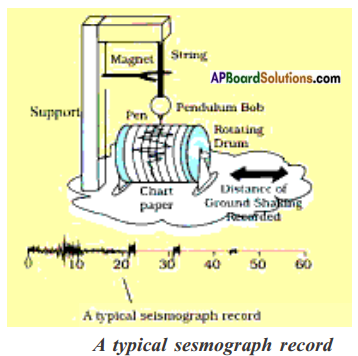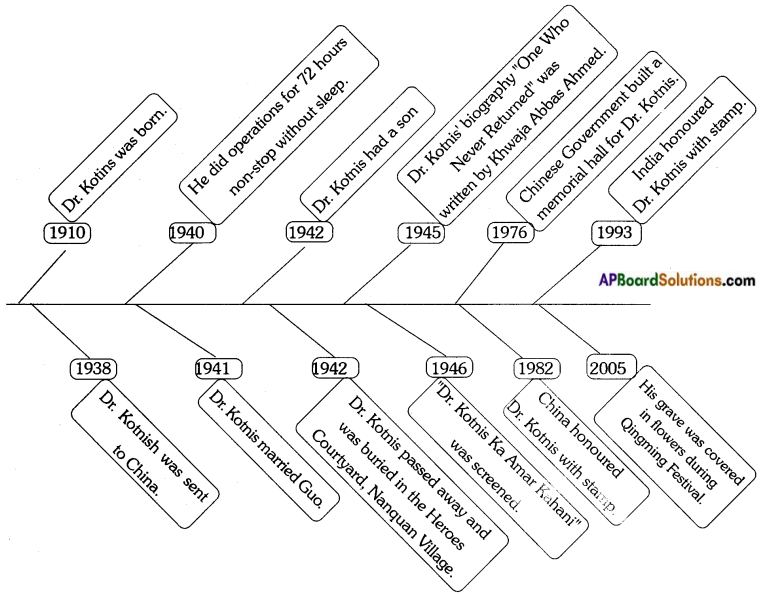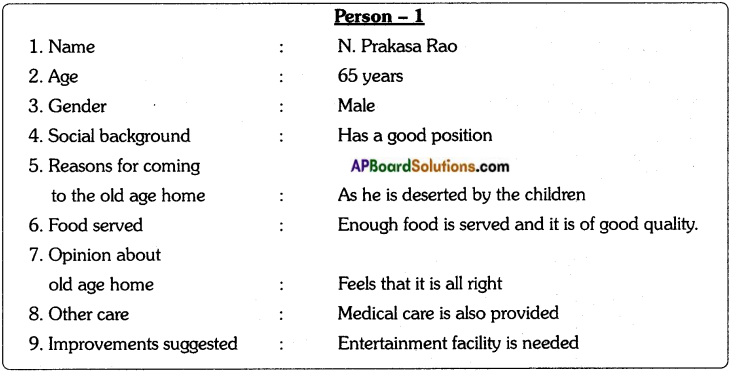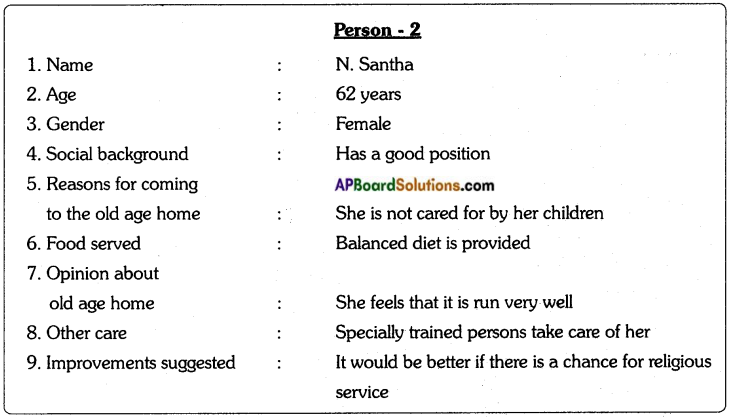AP State Syllabus AP Board 8th Class English Textbook Solutions Chapter 3B The Selfish Giant Part 2 Textbook Questions and Answers.
AP State Syllabus 8th Class English Solutions Chapter 3B The Selfish Giant Part 2
8th Class English Chapter 3B The Selfish Giant Part 2 Textbook Questions and Answers
Comprehension
Answer the following questions.
Question 1.
How is the ‘child’ different from other children?
Answer:
The child is not an ordinary child. He is an angel who came from the heaven. He changed the attitude of the Giant. He took him to the heaven.
![]()
Question 2.
How does the narrator explain the idea of spring time? Pick out some expressions.
Answer:
Spring is season of new life and liveliness. When there was the spring in the garden, it was all beautiful with the singing of birds and flowers. When the spring didn’t come there, it was all cold and lifeless.
The expressions which explain the idea of spring time :
- ‘The birds did not come to sing, and the trees forgot to blossom.” (when the spring did not come)
- “I heard some lovely music.”
- ‘The Hail has stopped dancing.”
- ‘The North Wind has ceased roaring.” (ii to v expressions suggest the coming of the spring.)
- “A delicious smell is coming from the window.”
Question 3.
What are the figurative expressions used in the play? List them and mention their significance.
Answer:
The figurative expressions used in the play are:
i) Simile: a) Here and there over the grass stood beautiful flowers like stars – flowers are compared to ‘stars’ using ‘like’.
ii) Personification :
a) The people who were pleased best were the Snow and the Frost.
b) Spring has forgotten this garden.
c) The snow covered up the grass with her great white cloak, and the Frost painted all the trees silver.
d) He roared all day about the garden and rejoiced in blowing the chimney-pots over.
e) The North Wind, and the Hail, and the Frost, and the snow danced about through the trees.
f) The Hail has stopped dancing. g) The North wind has ceased his roaring.
h) The flowers were looking up through the green grass and laughing.
i) It is merely the spring asleep.
j) The flowers are resting.
‘Snow’, ‘Frost’, ‘Spring’, ‘Hail’, ‘North Wind’ and Flowers are represented as human beings.
iii) Metaphor :
My garden shall be the children’s playground for ever and ever.
The word ‘garden’ is used to describe the word ‘playground.’
![]()
Question 4.
What is the central theme of the play?
Answer:
The two main themes of the play are ‘selfishness’ and ‘love’. People who are selfish don’t want to share their things with others. They want to keep everything for themselves. But when they do that, they find themselves all alone. The giant was selfish. He didn’t want to share his garden with the children. He sent them away. But when he sent them away, he was left with nothing but cold and frost. When he didn’t have selfishness, he was taken to the Paradise. Our lives are empty and lonely without love. Love brightens our world and brings us happiness. When the Giant loved others, his garden became beautiful and full of life.
II. Complete the following sentences choosing the correct answers from the choices given below.
1. Both ‘over the grass stood beautiful flowers like stars’ and ‘the peach-trees broke into blossoms’ refer to ———–.
a) autumn
b) spring
c) winter
2. The Giant observed the children ———–.
a) hiding in the garden
b) playing in the garden
c) dancing in the garden
3. The Giant knew the spring had arrived from ———–.
a) song of a linnet bird
b) sounds made by the children
c) blossoms in the garden
4. The little boy ———–.
a) called the Giant by gesturing
b) flung hands around the neck
c) ran towards the Giant
5. ‘What a marvellous sight that is !’ is said by ———–.
a) the children
b) the little boy
c) the Giant
Answer:
1 – b
2 – b
3 – a
4 – b
5 – c
![]()
Vocabulary
Look at the following underlined phrase taken from the text and know the meanings.
1. Peach-trees that in the spring time broke out into delicate blossom.
In the above sentence, the phrase ‘broke out’ means ‘came out’.
A) Refer to a dictionary and find out phrasal verbs beginning with ‘break’.
Use them in your own sentences.
Answer:
1. breakaway 2. breakdown 3. break into 4. breakout
1) break away:
The prisoner broke away from jail last night.
2) break down:
Our jeep has broken down on the outskirts of the city.
3) break into:
The burglars broke into the house when the owners away.
4) break out:
The war broke out in the middle east.
B) Pick out some more phrasal verbs from the play ‘The Selfish Giant’.
1) put up
2) cover up
3) blow over
4) look out
5) look up
6) knock down
II. Read the underlined part of the sentence taken from the text.
This is a delightful spot.
In the above sentence ‘delightful’ means ‘pleasant’, the opposite (antonym) of it is ‘gloomy’. Pick out antonyms of the underlined words from the play and use them in your own sentences.
1. Nobody likes to be in hell.
Answer:
Everybody likes to be in paradise.
2. You should be beware of your foe.
Answer:
I met my friend yesterday.
![]()
3. It started raining cats and dogs.
Answer:
The police stopped me.
4. She uncovered her head after she came out of the temple.
Answer:
He covered his face with a kerchief.
5. This is the nearest shop to my house.
Answer:
There is a medical shop in the farthest corner.
III. Look at the following sentence taken from the text.
Ex: I heard the children whispering outside the wall on their way to school.
In the above sentence the underlined word indicates ’speaking quietly’ outside the wall so that nobody else could hear.
Now match the words in Column A with those in Column B with similar meaning.
| Column – A | Column – B |
| 1. screaming | A. continuous loud noise |
| 2. whisper | B. many people squeaking at the time |
| 3. yell | C. give a loud cry |
| 4. roaring | D. a long deep sound |
| 5. groan | E. speak quietly |
| 6. weep | E a loud high shout |
| 7. shriek | G. shout loudly |
| 8. babble | H. continuous short sounds |
| 9. mumble | I. soft quiet voice difficult to hear |
| 10. twitter | J. cry |
Answer:
1) C
2) E
3) G
4) A
5) D
6) J
7) F
8) B
9) I
10) H
![]()
IV. Choose the correct meaning for the underlined word.
1. The Giant put a notice board, trespassers will be prosecuted. ( )
a) persons who enter the premises without permission
b) persons who forcibly enter the premises
c) persons who officially enter the premises
2. The Giant was wrapped in furs and roared all day about the garden. ( )
a) made loud noise with anger
b) felt frustrated
c) looked pleased
3. There are twelve peach-trees that in spring-time broke out into delicate blossoms. ( )
a) leaves
b) flowers
c) fruits
4. He rattled on the roof the whole day. ( )
a) made a series of sounds
b) shouted
c) tapped
Answer:
1 – a
2 – a
3 – b
4 – a
Grammar
Read the following sentences.
1. He is swimming in a pool.
2. Swimming is good for health.
The ‘-ing’ form in the first sentence is called a present participle. It is most commonly used as part of continuous tenses and after verbs of perception such as ‘see, hear, notice and watch’.
Examples: 1. I saw him crossing the road.
2. Didn’t you hear the cat meowing?
On the other hand, the ‘-ing’ form in the second sentence is called a gerund. It acts as a noun. It is used as the subject, or object of a sentence and after prepositions.
Examples: 1. He likes swimming. 2. He is fond of swimming.
In both cases, the form is the same. The difference is in their functions in a sentence.
![]()
I. Identify the gerunds and present participles in the following sentences.
1. The North Wind ceased roaring.
2. The Child did not see the giant coming.
3. I heard the children whispering outside the wall on their way to school.
4. Why is the Spring so late in coming?
5. Walking makes healthy and wealthy.
Answer:
1. roaring
2. coming
3. whispering
4. coming
5. Walking
Writing
Read the following notice taken from the play.
TRESPASSERS WILL BE PROSECUTED
Write a similar one-line notice each that you may find in the following places.
1. Hospitals: ———–
2. Banks: ———–
3. Public places: ———–
4. Schools: ———–
5. At home: ———–
Answer:
Hospitals: Keep absolute silence.
Banks: Switch off vour cell-phones.
Public places: Don’t Dark vour vehicles here.
Schools: Don’t throw waste material in school premises.
At home: Beware of dogs.
![]()
Listening
Listen to a description and answer the following questions.
Lal Bagh
Dear Students, now we are in Lal Bagh Garden, Bengaluru. It means “The Red Garden” in English. It is one of the famous gardens in India. It is located to the South of the city centre and Bengaluru’s main attraction.
Hyder Ali, the ruler of Mysore commissioned the building of the garden in 1760. His son Tippu Sultan completed it by importing trees and plants from several countries. The garden has over 1,000 species of flora. The garden is spread over 240 acres. The Glass House is the main attraction in this garden, modeled on London’s Crystal Palace.
Look there, you can see a 300 year old “Christmas Tree”. There are many such old trees we can find in the garden. Children, look there, you can find the scientific name tag to each tree.
Now we are moving towards the Rose Garden, which is another highlight of Lai Bagh. It has almost all the species of roses available worldwide.
Now we are at the giant Electronic Quartz Flower clock built by HMT. In this garden flower shows are conducted every year to educate people about different flora and help cultivate the habit of growing plants among the public.
1. Where is the garden located?
Answer:
The garden is located to South of Bengaluru.
2. What is so special about it?
Answer:
The Glass House, the 300 year old ‘Christmas Tree,’ the Rose Garden and the giant electronic Quartz Flower clock are the specialities of the garden.
![]()
Oral Activity
Talk about any garden you have visited.
Answer:
In the last summer when I went to my uncle’s city, Mysore, I visited Brindavan Gardens. These gardens are the most famous gardens of Mysore. These gardens are located about 19 kms. from the heart of Mysore. These gardens are laid out below the Krishnaraja Sagar dam built across the river Cauvery. These gardens are famous for the ilium :nated dancing fountains that come to life after sunset. Brindavan gardens are noted for their beauty. These gardens are full of life both in the morning and evening. These gardens are a boon for Mysore people. We entered the garden after sunset as it is the best time to visit the gardens. At that time all the bright colourful fountains usually come alive and seem to dance with joy to the accompanying music. At that time the entire gardens are transformed into a fairy land. There are beautiful lawns and shrubs with colouful lamps around them. There are so many tall, green trees. The flower-beds are a store house of beauty. They add a splash of colour to the fresh green of the lawns. We find a great peace there. The sweet and merry notes of the birds are very pleasant to the ears. We enjoyed ourselves visiting such a beautiful garden. We played for about two hours in the evening. Really it is a memorable thing in my life. I am very much thankful to my uncle as he gave me an opportunity to visit such a wonderful garden.
Study Skills
Read the play ‘The Selfish Giant’ once again and summarize it. Remember to follow the points given below.
- Identify the main and subordinate ideas, section wise/part wise.
- Separate the main idea from the subordinate ideas.
- Identify the words/phrases which carry ideas.
- Link your ideas properly with appropriate linkers.
- Use the words/phrases that express the essence of the text.
- Present the ideas briefly.
Answer:
A Giant who lived in a big house had a beautiful garden. Whenever he was away, chil-dren used to come there to play. One day the Giant went to visit his friend the Cornish ogre and came after seven years. When he arrived, he saw the children palying in his garden. He angrily chased them away and built a high wall around his garden. After the children stopped coming to the garden, the trees and flowers were so sad that they lost their beauty and were covered with snow and frost. There was no singing of birds. The spring was there all over the country but in the Giant’s garden it was still winter.
![]()
One morning, the Giant heard the lovely singing of a linnet bird and thought that the spring had come at last. He saw children playing in the garden. The children had crept in through a little hole in the garden. He understood that he had been selfish and was very sorry for what he had done. He saw a little boy who was too small to get into a tree and that tree was still covered with frost and snow. The Giant put the little child into the tree gently. He knocked down the wall and the children were allowed to play there in his garden whenever they pleased. But the little boy whom he helped was never seen again in his garden. The Giant grew old and feeble. He sat there watching the children at their games. One morning he saw the little boy under a tree and ran to him. When he went near to the little child, he saw wounds on the child’s hands and feet. He got angered and asked the little child who had hurt him. He wanted to kill the person who had wounded the little child. But the little child told him that he should not do that and those were the wounds of love. The little child took the Giant to Paradise.
The Selfish Giant Part 2 Summary in English
One morning, when the Giant was lying awake in bed, he heard some lovely music. It sounded very sweet to the Giant’s ears. A little linnet was singing outside his window. The Giant thought that the spring had come at last. The children had crept in through a little hole in the wall. They sat in the branches of the trees and the trees were so glad to have the children back again. In the farthest corner of the garden it was still winter. In that corner, a little boy was trying to reach up to the branches but he couldn’t as he was so small. The Giant’s heart melted. He understood that he had been selfish. He was really sorry for what he had done. He went into the garden and the frightened children ran away and the garden became winter again. Only the little boy was there and the Giant put him gently up into the tree. The tree broke at once into blossom, the birds sang and the boy kissed him. The other children saw that and came running back. With them the spring came. The Giant was no longer wicked. He took an axe and broke the wall. He started playing with them. In the evening, the Giant came to know that the little boy whom he put into the tree had gone away. Every afternoon, the children came and played with the Giant. But he never saw again the little boy who he loved. The Giant had grown old and feeble. So, he sat there watching the children at their games. One winter morning, the Giant filled with wonder to see the little boy standing under a tree in the farthest comer of the garden. In great joy, the Giant ran downstairs out into the garden and went near to the child. His face grew red with anger when he saw the wounds on the boy’s hands and feet. The Giant cried that he would kill the person who had wounded the little boy. The child asked the Giant not to do that as those were the wounds of love. The little boy asked the Giant to come with him to his garden. The child climbed into the old Giant’s arms and they both walked into the garden of Paradise.
![]()
About the author
Oscar Wilde (16 October 1854-30 November 1900) was an Irish writer and poet. After writing in different forms throughout the 1880s, he became one of London’s most popular playwrights in the early 1890s. Today he is remembered for his epigrams and plays. Oscar Wilde is best known for the novel The Picture of Dorian Gray and the play The Importance of Being Earnest. The Happy Prince and Other Tales is a collection of children’s stories.
The Selfish Giant Part 2 Glossary
linnet bird (n): a small brown and grey bird
hail (n): small balls of ice that fall like rain
cease (v): stop happening
twittering (v): making a series of short high sounds
sneeze (v): suddenly expel air from the nose and mouth due to irritation in
one’s nostrils
feeble (adj): lacking strength
hath (v): has (old usage)
thee (pro): you (old usage)
slay (v): kill
![]()
thou (pro): you (as the singular subject of a verb)
blossoms (n): flowers
farthest (adj): at the greatest distance
admire (v): to respect somebody for what they are
marvellous (adj): wonderful, extremely good
draw (v): to move in the direction mentioned
art (v) (old use): are
melt (v): to become liquid


